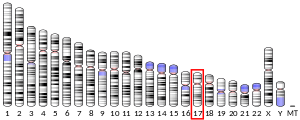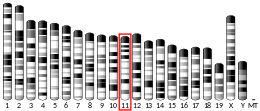Adrenodoxin reductase
Adrenodoxin reductase (Enzyme Nomenclature name: adrenodoxin-NADP+ reductase, EC 1.18.1.6), was first isolated from bovine adrenal cortex where it functions as the first enzyme in the mitochondrial P450 systems that catalyze essential steps in steroid hormone biosynthesis.[5] [6] Examination of complete genome sequences revealed that adrenodoxin reductase gene is present in most metazoans and prokaryotes.[7]
Nomenclature
The name of the enzyme was coined based on its function to reduce a [2Fe-2S] (2 iron, 2 sulfur) electron-transfer protein that was named adrenodoxin. Later, in some studies, the enzyme was also referred to as a "ferredoxin reductase", as adrenodoxin is a ferredoxin. In the human gene nomenclature, the standard name is ferredoxin reductase and the symbol is FDXR, with ADXR specified as a synonym.
The assignment of the name "ferredoxin reductase" has been criticized as a misnomer because determination of the structure of adrenodoxin reductase revealed that it is completely different from that of plant ferredoxin reductase and there is no homology between these two enzymes.[8][9][10] With more proteins with a ferroxodin-reducing activity discovered in both families as well as novel families, this enzyme activity is now seen as an example of convergent evolution.[11][12]
Function
Adrenodoxin reductase is a flavoprotein as it carries a FAD type coenzyme. The enzyme functions as the first electron transfer protein of mitochondrial P450 systems such as P450scc.[6] The FAD coenzyme receives two electrons from NADPH and transfers them one at a time to the electron transfer protein adrenodoxin.[13] Adrenodoxin functions as a mobile shuttle that transfers electrons between ADXR and mitochondrial P450s.[14]
It catalyzes the following reaction:
- NADPH + 2 oxidized adrenodoxin —→ 2 reduced adrenodoxin + NADP+ + H+
Gene structure
The cDNA for adrenodoxin reductase was first cloned in 1987.[15] In both bovine and human genomes there is only a single copy of the gene.[15][16]
Sites of expression
ADXR gene is expressed in all tissues that have mitochondrial P450s. The highest levels of the enzyme are found in the adrenal cortex, granulosa cells of the ovary and leydig cells of the testis that specialize in steroid hormone synthesis.[6][17] Immmunofluorescent staining shows that enzyme is localized in mitochondria.[18] The enzyme is also expressed in the liver, the kidney and the placenta.
Enzyme structure
Adrenodoxin reductase has two domains that bind NADPH and FAD separately.[7] The FAD and NADP binding sites of the enzyme were predicted by sequence analysis of the enzyme. [19]
While the FAD-binding site has a consensus sequence (Gly-x-Gly-x-x-Gly) that is similar to other Rossmann folds in FAD and NAD binding sites,[20] the NADPH binding site consensus sequence differs from the FAD-binding site by the substitution of an alanine instead of the last Gly (Gly-x-Gly-x-x-Ala).[19][7] The location of these FAD and NADP binding sites were confirmed by the crystal structure of the enzyme.[10]
References
- GRCh38: Ensembl release 89: ENSG00000161513 - Ensembl, May 2017
- GRCm38: Ensembl release 89: ENSMUSG00000018861 - Ensembl, May 2017
- "Human PubMed Reference:". National Center for Biotechnology Information, U.S. National Library of Medicine.
- "Mouse PubMed Reference:". National Center for Biotechnology Information, U.S. National Library of Medicine.
- Omura, T.; Sanders, E.; Estabrook, R.W.; Cooper, D.Y.; Rosenthal, O. (December 1966). "Isolation from adrenal cortex of a nonheme iron protein and a flavoprotein functional as a reduced triphosphopyridine nucleotide-cytochrome P-450 reductase". Archives of Biochemistry and Biophysics. 117 (3): 660–673. doi:10.1016/0003-9861(66)90108-1.
- Hanukoglu I (Dec 1992). "Steroidogenic enzymes: structure, function, and role in regulation of steroid hormone biosynthesis". The Journal of Steroid Biochemistry and Molecular Biology. 43 (8): 779–804. doi:10.1016/0960-0760(92)90307-5. PMID 22217824.
- Hanukoglu I (2017). "Conservation of the Enzyme-Coenzyme Interfaces in FAD and NADP Binding Adrenodoxin Reductase-A Ubiquitous Enzyme". Journal of Molecular Evolution. 85 (5): 205–218. Bibcode:2017JMolE..85..205H. doi:10.1007/s00239-017-9821-9. PMID 29177972.
- Hanukoglu I (1996). Electron transfer proteins of cytochrome P450 systems (PDF). Adv. Mol. Cell Biol. Advances in Molecular and Cell Biology. 14. pp. 29–55. doi:10.1016/S1569-2558(08)60339-2. ISBN 9780762301133.
- Ziegler GA, Vonrhein C, Hanukoglu I, Schulz GE (Jun 1999). "The structure of adrenodoxin reductase of mitochondrial P450 systems: electron transfer for steroid biosynthesis". Journal of Molecular Biology. 289 (4): 981–90. doi:10.1006/jmbi.1999.2807. PMID 10369776.
- Ziegler GA, Schulz GE (2000). "Crystal structures of adrenodoxin reductase in complex with NADP+ and NADPH suggesting a mechanism for the electron transfer of an enzyme family". Biochemistry. 39 (36): 10986–95. doi:10.1021/bi000079k. PMID 10998235.
- Aliverti, A.; Pandini, V.; Pennati, A.; de Rosa, M.; Zanetti, G. (Jun 2008). "Structural and functional diversity of ferredoxin-NADP+ reductases" (PDF). Arch Biochem Biophys. 474 (2): 283–91. doi:10.1016/j.abb.2008.02.014. hdl:2434/41439. PMID 18307973.
- Spaans, SK; Weusthuis, RA; van der Oost, J; Kengen, SW (2015). "NADPH-generating systems in bacteria and archaea". Frontiers in Microbiology. 6: 742. doi:10.3389/fmicb.2015.00742. PMC 4518329. PMID 26284036.
- Lambeth JD, Kamin H (Jul 1976). "Adrenodoxin reductase. Properties of the complexes of reduced enzyme with NADP+ and NADPH". The Journal of Biological Chemistry. 251 (14): 4299–306. PMID 6475.
- Hanukoglu I, Jefcoate CR (Apr 1980). "Mitochondrial cytochrome P-450scc. Mechanism of electron transport by adrenodoxin" (PDF). The Journal of Biological Chemistry. 255 (7): 3057–61. PMID 6766943.
- Hanukoglu I, Gutfinger T, Haniu M, Shively JE (Dec 1987). "Isolation of a cDNA for adrenodoxin reductase (ferredoxin-NADP+ reductase). Implications for mitochondrial cytochrome P-450 systems". European Journal of Biochemistry. 169 (3): 449–455. doi:10.1111/j.1432-1033.1987.tb13632.x. PMID 3691502.
- Solish SB, Picado-Leonard J, Morel Y, Kuhn RW, Mohandas TK, Hanukoglu I, Miller WL (Oct 1988). "Human adrenodoxin reductase: two mRNAs encoded by a single gene on chromosome 17cen----q25 are expressed in steroidogenic tissues". Proceedings of the National Academy of Sciences of the United States of America. 85 (19): 7104–7108. Bibcode:1988PNAS...85.7104S. doi:10.1073/pnas.85.19.7104. PMC 282132. PMID 2845396.
- Hanukoglu I, Hanukoglu Z (May 1986). "Stoichiometry of mitochondrial cytochromes P-450, adrenodoxin and adrenodoxin reductase in adrenal cortex and corpus luteum. Implications for membrane organization and gene regulation". European Journal of Biochemistry. 157 (1): 27–31. doi:10.1111/j.1432-1033.1986.tb09633.x. PMID 3011431.
- Hanukoglu I, Suh BS, Himmelhoch S, Amsterdam A (October 1990). "Induction and mitochondrial localization of cytochrome P450scc system enzymes in normal and transformed ovarian granulosa cells". The Journal of Cell Biology. 111 (4): 1373–81. doi:10.1083/jcb.111.4.1373. PMC 2116250. PMID 2170421.
- Hanukoglu I, Gutfinger T (Mar 1989). "cDNA sequence of adrenodoxin reductase. Identification of NADP-binding sites in oxidoreductases". European Journal of Biochemistry / FEBS. 180 (2): 479–84. doi:10.1111/j.1432-1033.1989.tb14671.x. PMID 2924777.
- Hanukoglu I (2015). "Proteopedia: Rossmann fold: A beta-alpha-beta fold at dinucleotide binding sites". Biochem Mol Biol Educ. 43 (3): 206–209. doi:10.1002/bmb.20849. PMID 25704928.
External links
- Human FDXR genome location and FDXR gene details page in the UCSC Genome Browser.
Further reading
- Sparkes RS, Klisak I, Miller WL (Jun 1991). "Regional mapping of genes encoding human steroidogenic enzymes: P450scc to 15q23-q24, adrenodoxin to 11q22; adrenodoxin reductase to 17q24-q25; and P450c17 to 10q24-q25". DNA and Cell Biology. 10 (5): 359–65. doi:10.1089/dna.1991.10.359. PMID 1863359.
- Coghlan VM, Vickery LE (Oct 1991). "Site-specific mutations in human ferredoxin that affect binding to ferredoxin reductase and cytochrome P450scc". The Journal of Biological Chemistry. 266 (28): 18606–12. PMID 1917982.
- Lin D, Shi YF, Miller WL (Nov 1990). "Cloning and sequence of the human adrenodoxin reductase gene". Proceedings of the National Academy of Sciences of the United States of America. 87 (21): 8516–20. Bibcode:1990PNAS...87.8516L. doi:10.1073/pnas.87.21.8516. PMC 54987. PMID 2236061.
- Usanov SA, Chernogolov AA, Honkakoski P, Lang M, Passanen M, Raunio H, Pelkonen O (May 1990). "[Cholesterol-hydroxylating cytochrome P-450 from bovine adrenal cortex mitochondria and human placenta: immunochemical properties and structural characteristics]". Biokhimiya. 55 (5): 865–77. PMID 2393675.
- Sasano H, Sasano N, Okamoto M, Nonaka Y (May 1989). "Immunohistochemical demonstration of adrenodoxin reductase in bovine and human adrenals". Pathology, Research and Practice. 184 (5): 473–9. doi:10.1016/s0344-0338(89)80137-2. PMID 2748461.
- Usanov SA, Honkakoski P, Lang MA, Pasanen M, Pelkonen O, Raunio H (Oct 1989). "Comparison of the immunochemical properties of human placental and bovine adrenal cholesterol side-chain cleavage enzyme complex". Biochimica et Biophysica Acta (BBA) - Protein Structure and Molecular Enzymology. 998 (2): 189–95. doi:10.1016/0167-4838(89)90272-0. PMID 2790061.
- Maruyama K, Sugano S (Jan 1994). "Oligo-capping: a simple method to replace the cap structure of eukaryotic mRNAs with oligoribonucleotides". Gene. 138 (1–2): 171–4. doi:10.1016/0378-1119(94)90802-8. PMID 8125298.
- Suzuki Y, Yoshitomo-Nakagawa K, Maruyama K, Suyama A, Sugano S (Oct 1997). "Construction and characterization of a full length-enriched and a 5'-end-enriched cDNA library". Gene. 200 (1–2): 149–56. doi:10.1016/S0378-1119(97)00411-3. PMID 9373149.
- Müller JJ, Lapko A, Bourenkov G, Ruckpaul K, Heinemann U (Jan 2001). "Adrenodoxin reductase-adrenodoxin complex structure suggests electron transfer path in steroid biosynthesis". The Journal of Biological Chemistry. 276 (4): 2786–9. doi:10.1074/jbc.M008501200. PMID 11053423.
- Gonzalez MI, Robins DM (Mar 2001). "Oct-1 preferentially interacts with androgen receptor in a DNA-dependent manner that facilitates recruitment of SRC-1". The Journal of Biological Chemistry. 276 (9): 6420–8. doi:10.1074/jbc.M008689200. PMID 11096094.
- Tuckey RC, Headlam MJ (Jun 2002). "Placental cytochrome P450scc (CYP11A1): comparison of catalytic properties between conditions of limiting and saturating adrenodoxin reductase". The Journal of Steroid Biochemistry and Molecular Biology. 81 (2): 153–8. doi:10.1016/S0960-0760(02)00058-4. PMID 12137805.
- Liu G, Chen X (Oct 2002). "The ferredoxin reductase gene is regulated by the p53 family and sensitizes cells to oxidative stress-induced apoptosis". Oncogene. 21 (47): 7195–204. doi:10.1038/sj.onc.1205862. PMID 12370809.
- Araya Z, Hosseinpour F, Bodin K, Wikvall K (Jun 2003). "Metabolism of 25-hydroxyvitamin D3 by microsomal and mitochondrial vitamin D3 25-hydroxylases (CYP2D25 and CYP27A1): a novel reaction by CYP27A1". Biochimica et Biophysica Acta (BBA) - Molecular and Cell Biology of Lipids. 1632 (1–3): 40–7. doi:10.1016/S1388-1981(03)00062-3. PMID 12782149.
- Thiboutot D, Jabara S, McAllister JM, Sivarajah A, Gilliland K, Cong Z, Clawson G (Jun 2003). "Human skin is a steroidogenic tissue: steroidogenic enzymes and cofactors are expressed in epidermis, normal sebocytes, and an immortalized sebocyte cell line (SEB-1)". The Journal of Investigative Dermatology. 120 (6): 905–14. doi:10.1046/j.1523-1747.2003.12244.x. PMID 12787114.
- Kimura K, Wakamatsu A, Suzuki Y, Ota T, Nishikawa T, Yamashita R, Yamamoto J, Sekine M, Tsuritani K, Wakaguri H, Ishii S, Sugiyama T, Saito K, Isono Y, Irie R, Kushida N, Yoneyama T, Otsuka R, Kanda K, Yokoi T, Kondo H, Wagatsuma M, Murakawa K, Ishida S, Ishibashi T, Takahashi-Fujii A, Tanase T, Nagai K, Kikuchi H, Nakai K, Isogai T, Sugano S (Jan 2006). "Diversification of transcriptional modulation: large-scale identification and characterization of putative alternative promoters of human genes". Genome Research. 16 (1): 55–65. doi:10.1101/gr.4039406. PMC 1356129. PMID 16344560.




